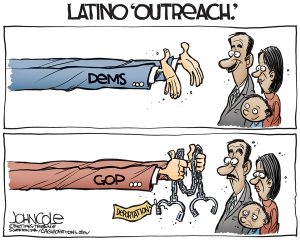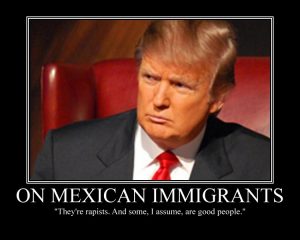More than ever before, the 2016 Presidential election is characterized by polarity– both candidates take pride in being the exact opposite of their opponent. In fact, Hillary Clinton and Donald Trump have created platforms based simply on not being like one another. This is especially evident in Trump’s and Clinton’s stances on immigration.
Since the beginning of election season, both Presidential hopefuls have vividly painted pictures of what immigration reform looks like to them specifically. Their policies and promises are more than immigration reform- these ideas contribute to the larger narratives of both campaigns and highlight the fundamental American values that each candidate has used to define themselves in the race for the Presidency.
So, if each candidate’s positions on immigration point to the larger narrative of their respective campaigns, can’t your views on immigration reveal deeper values within you as an American?
Below is a set of questions about immigration policies in the U.S. Take note of how many times you answer with a certain letter, and compare your own views with the views of a particular candidate at the end of the questions.
How do you think we should approach the U.S.-Mexico border from an immigration standpoint?
a) America should initiate the building of a physical structure that inhibits the entry of illegal aliens.
b) America should ramp up its technology and border patrol manpower to inhibit the entry of illegal aliens.
How should we approach citizenship for illegal immigrants that are already in the United States?
a) Such immigrants should have to return to their home countries and apply for legal entry to return to the United States.
b) Legislation should be passed that ensures a route to citizenship that does not require deportation.
How much assistance should illegal immigrants receive from government programs?
a) Such immigrants should have no access to government-backed assistance. The ones that already do are priority for deportation.
b) As long as such immigrants have paid into the system for 10 years, they should have access to things like Social Security.
How should we handle U.S. cities that have become “sanctuaries” for illegal immigrants?
a) Those cities should be blocked from receiving taxpayer dollars until they agree to cooperate with federal immigration authorities.
b) Local governments and law enforcement should be trusted to protect themselves, and the federal government should not interfere with local ordinances that have been passed in relation to illegal immigrants residing in a particular city.
What do your views say about you?
If you answered mostly A…
Your immigration views align more closely with those of Donald J. Trump. His campaign has used these stances to invoke a sense of nationalism among his supporters and publics. According to your views on immigration, you also posses a strong sense of nationalism. His “America First” narrative is fostered by the idea that America is a country primarily for Americans, not for outsiders- especially illegal outsiders. Ultimately, he has rallied his support base around the idea that America can be greater if we take steps to protect it from outside entrants.
If you answered mostly B…
Your immigration views align more closely with those of Hillary Clinton. Her campaign has used these stances to posit feelings of diversity and inclusion- values that cater to the deeply rooted “melting pot” ideal that Americans have possessed for decades. According to your views, you also value these ideas. Clinton’s diversity narrative is augmented by the idea that American freedom is for all.








